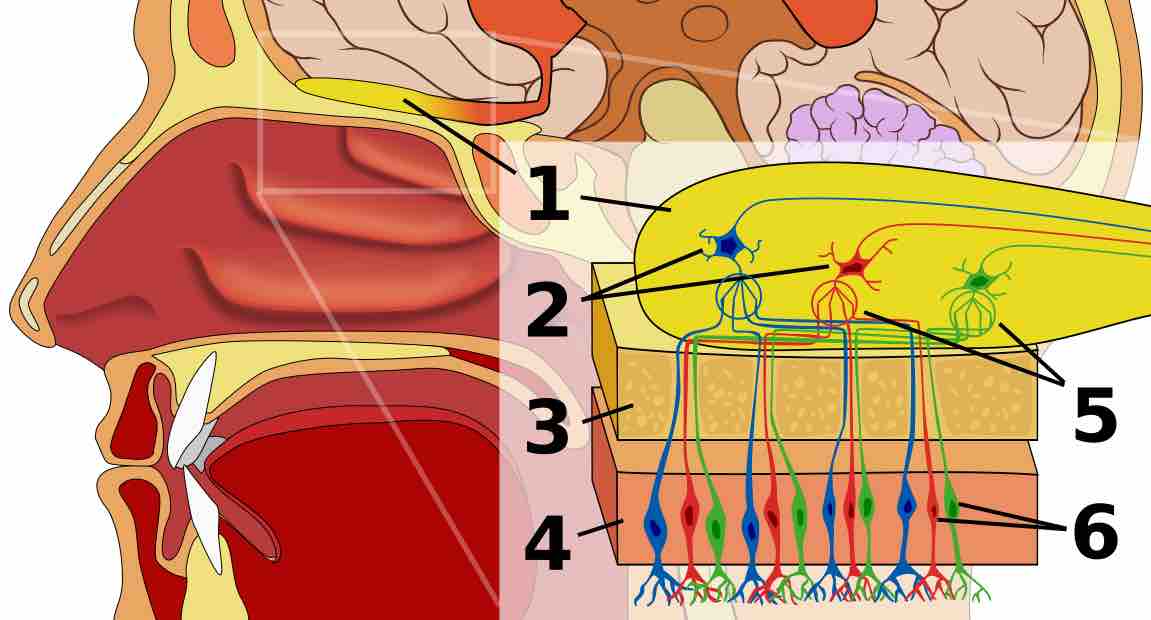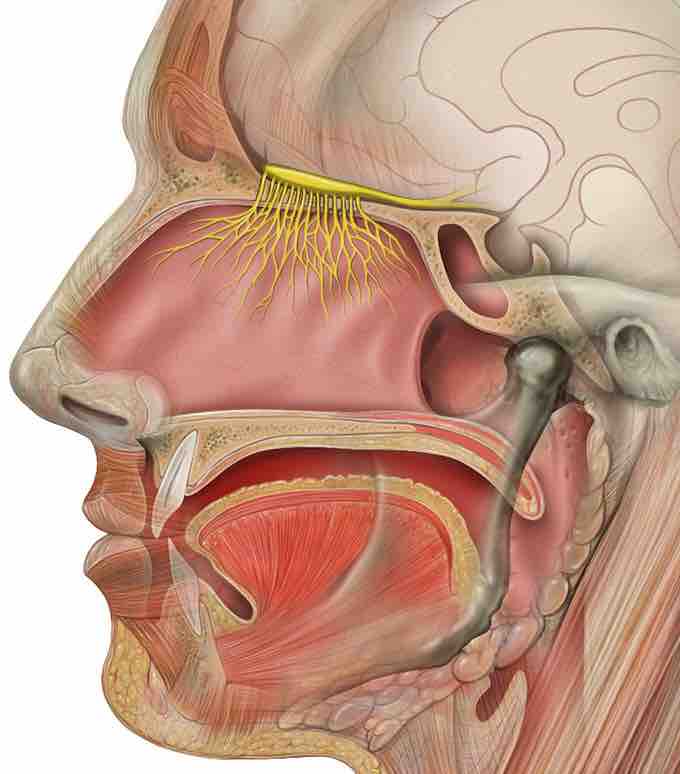The olfactory system gives humans their sense of smell by inhaling and detecting odorants in the environment. Olfaction is physiologically related to gustation, the sense of taste, because of its use of chemoreceptors to discern information about substances. Perceiving complex flavors requires recognizing taste and smell sensations at the same time, an interaction known as chemoreceptive sensory interaction. This causes foods to taste different if the olfactory system is compromised. However, olfaction is anatomically different from gustation because it uses the sensory organs of the nose and nasal cavity to capture smells. Humans can identify a large number of odors and use this information to interact successfully with their environment.
The Nose and Nasal Cavity
Olfactory sensitivity is directly proportional to spatial area in the nose—specifically the olfactory epithelium, which is where odorant reception occurs. The area in the nasal cavity near the septum is reserved for the olfactory mucous membrane, where olfactory receptor cells are located. This area is a dime-sized region called the olfactory mucosa. In humans, there are about 10 million olfactory cells, each of which has 350 different receptor types composing the mucous membrane. Each of the 350 receptor types is characteristic of only one odorant type. Each functions using cilia, small hair-like projections that contain olfactory receptor proteins. These proteins carry out the transduction of odorants into electrical signals for neural processing.

The Olfactory System
A cross-section of the olfactory system that labels all of the structures necessary to process odor information.
Olfactory transduction is a series of events in which odor molecules are detected by olfactory receptors. These chemical signals are transformed into electrical signals and sent to the brain, where they are perceived as smells.
Once ligands (odorant particles) bind to specific receptors on the external surface of cilia, olfactory transduction is initiated. In mammals, olfactory receptors have been shown to signal via G protein. This is a similar type of signaling of other known G protein-coupled receptors (GPCR). The binding of an odorant particle on an olfactory receptor activates a particular G protein (Gαolf), which then activates adenylate cyclase, leading to cAMP production. cAMP then binds and opens a cyclic nucleotide-gated ion channel. This opening allows for an influx of both Na+ and Ca2+ ions into the cell, thus depolarizing it. The Ca2+ in turn activates chloride channels, causing the departure of Cl-, which results in a further depolarization of the cell.

Olfactory Nerve
The olfactory nerve connects the olfactory system to the central nervous system to allow processing of odor information.
Interpretation of Smells
Individual features of odor molecules descend on various parts of the olfactory system in the brain and combine to form a representation of odor. Since most odor molecules have several individual features, the number of possible combinations allows the olfactory system to detect an impressively broad range of smells. A group of odorants that shares some chemical feature and causes similar patterns of neural firing is called an odotope.
Humans can differentiate between 10,000 different odors. People (wine or perfume experts, for example) can train their sense of smell to become expert in detecting subtle odors by practicing retrieving smells from memory.
Smell and Memory
Odor information is easily stored in long-term memory and has strong connections to emotional memory. This is most likely due to the olfactory system's close anatomical ties to the limbic system and the hippocampus, areas of the brain that have been known to be involved in emotion and place memory. Human and animal brains have this in common: the amygdala, which is involved in the processing of fear, causes olfactory memories of threats to lead animals to avoid dangerous situations. The human sense of smell is not quite as powerful as most other animals' sense of smell, but smell is still deeply tied to human memory and emotion.
Pheromones are airborne, often odorless molecules that are crucial to the behavior of many animals. They are processed by an accessory of the olfactory system. Recent research shows that pheromones play a role in human attraction to potential mates, the synchronization of menstrual cycles among women, and the detection of moods and fear in others. Thanks in large part to the olfactory system, this information can be used to navigate the physical world and collect data about the people around us.